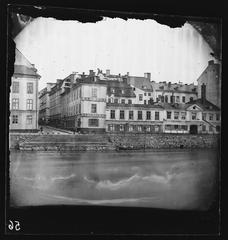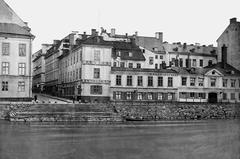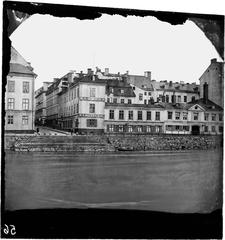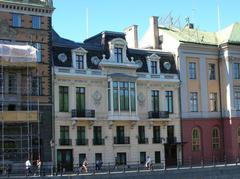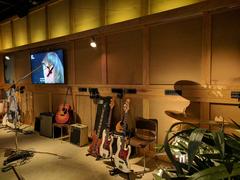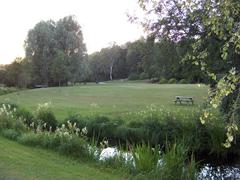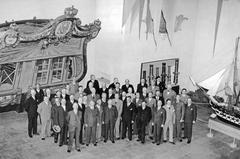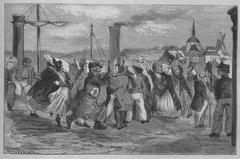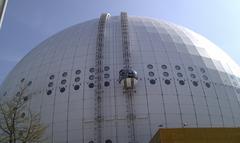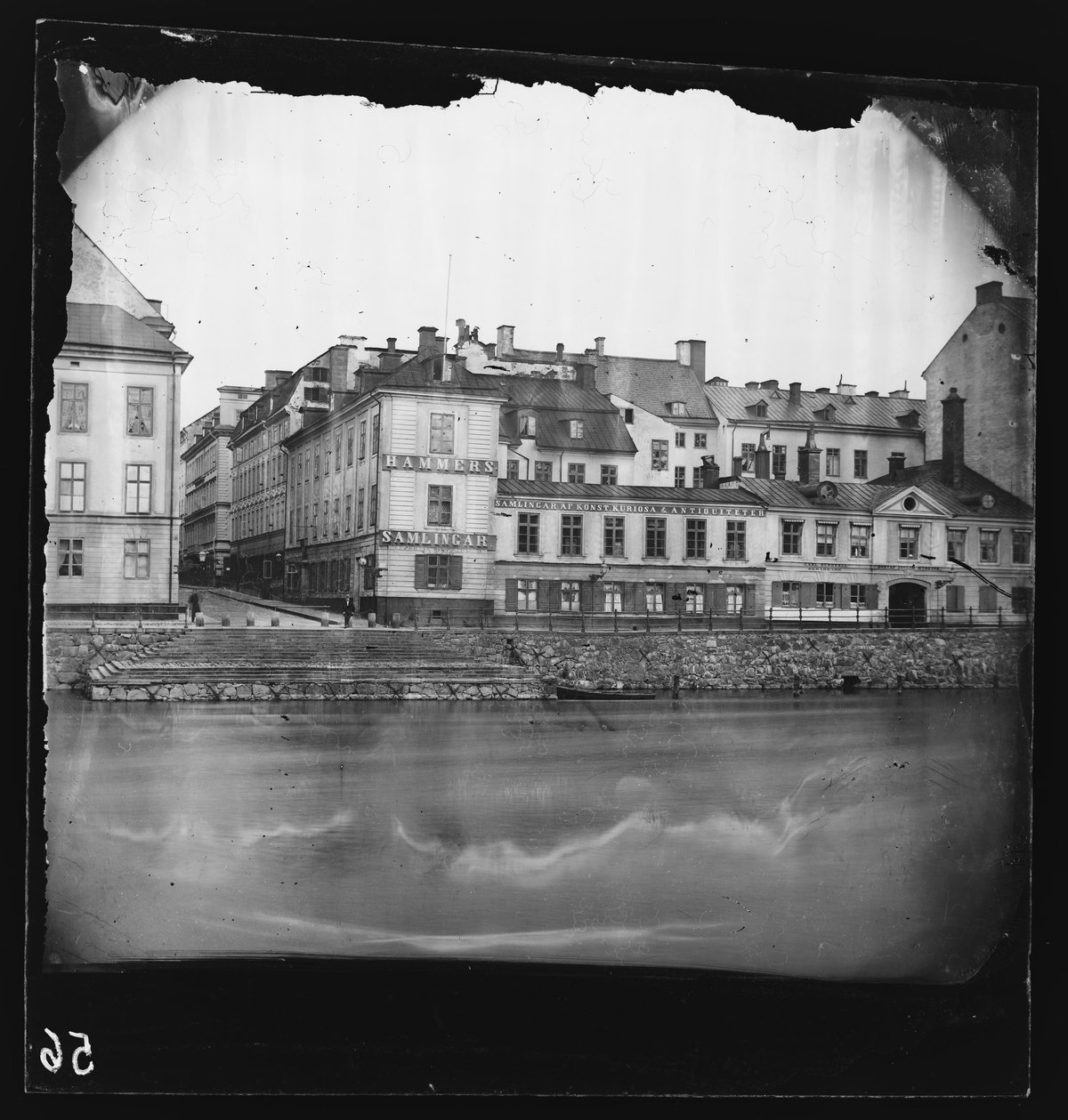
Leitfaden für den Besuch des Sager-Hauses, Stockholm, Schweden: Geschichte, Bedeutung, Besuchertipps und wesentliche Einblicke
Datum: 14.06.2025
Einführung in das Sager-Haus
Das Sager-Haus (schwedisch: Sagerska huset) befindet sich an der Strömgatan im Zentrum von Stockholm und blickt auf das Königliche Schloss und das Parlament. Seit 1995 dient es als offizielle Residenz des Ministerpräsidenten von Schweden und ist ein Paradebeispiel für Architektur im Stil der französischen Renaissance und des Barock-Revivals. Seine Entwicklung von einer Elite-Residenz des 17. Jahrhunderts zu einem Symbol moderner schwedischer Demokratie unterstreicht seine Doppelrolle als politischer Meilenstein und architektonisches Juwel.
Obwohl das Innere aus Sicherheitsgründen für die Öffentlichkeit geschlossen ist, machen die vornehme Fassade, die Aussicht auf das Flussufer und die Nähe zu wichtigen Sehenswürdigkeiten das Sager-Haus zu einem Highlight für Besucher, die sich für die historische und politische Geschichte Stockholms interessieren. Dieser Leitfaden beschreibt die architektonische Entwicklung, die politische und kulturelle Bedeutung des Sager-Hauses, Besucherinformationen und praktische Tipps für diejenigen, die seine Pracht von außen bestaunen möchten.
Für aktuelle Informationen zum öffentlichen Zugang oder zu Führungen konsultieren Sie die Website des schwedischen Parlaments und die Büros der schwedischen Regierung.
Inhaltsverzeichnis
- Frühe Geschichte und Bau
- Architektonische Entwicklung und Merkmale
- Übergang zur offiziellen Residenz
- Politische und kulturelle Bedeutung
- Lage und städtischer Kontext
- Besucherinformationen: Öffnungszeiten, Tickets und Barrierefreiheit
- Beste Ansichtspunkte & Nahegelegene Attraktionen
- Häufig gestellte Fragen (FAQ)
- Visuelle Galerie und Mediensuggestionen
- Fazit & Wichtige Tipps
- Referenzen
Frühe Geschichte und Bau
Das ursprüngliche Sager-Haus stammt aus den 1640er Jahren, als sich das Gebiet der Strömgatan zu einer prestigeträchtigen Adresse für Stockholms Elite entwickelte (Schwedisches Parlament). Im Laufe der Jahrhunderte durchlief das Gebäude mehrere Umbauten und Erweiterungen, die wechselnde architektonische Trends widerspiegelten. Die Bankiersfamilie Sager erwarb das Anwesen 1880, und auf Beschluss von Jean Sager verwandelte Architekt Jean René Pierre Litoux das Haus im Stil der französischen Renaissance-Revival. Die Renovierung von 1893 führte zu verzierten Steinarbeiten, Mansarddächern und schmiedeeisernen Balkonen (Stockholmer Stadtmuseum), was seine einzigartige Präsenz unter den historischen Residenzen Stockholms festigte.
Architektonische Entwicklung und Merkmale
Litoux’ Neugestaltung Ende des 19. Jahrhunderts verlieh dem Sager-Haus seinen bestimmenden Charakter im Stil französischer Châteaus: eine symmetrische Fassade mit aufwendigen Gesimsen, dekorativen Pilastern und einem markanten Mansarddach (Schwedisches Kulturerbeamt). Die Neorokoko-Details – wie Blumen- und Muschelverzierungen – mildern die imposanten barocken Formen.
Wichtige architektonische Highlights sind:
- Mansarddach: Inspiriert von François Mansart, fügt es Dachgeschossfläche und visuelle Dramatik hinzu (WorldAtlas).
- Verzierte Fassade: Stuck, Gesimse und Skulpturen um die Fenster.
- Paradesaal (Paradvåning): Eine formelle Empfangsebene für staatliche Empfänge.
- Symmetrie und Erhabenheit: Das Design des Gebäudes verkörpert Ordnung und Eleganz.
- Innenausstattung: Große Treppenhäuser, vergoldete Zierleisten, Marmorkamine und moderne Annehmlichkeiten seiner Zeit.
Trotz Umbauten im 20. Jahrhundert behält das Sager-Haus dank seines geschützten Status als Kulturerbe viel von seiner ursprünglichen dekorativen Gestaltung.
Übergang zur offiziellen Residenz
In den 1980er Jahren erforderte das Sager-Haus eine dringende Restaurierung. Die schwedische Regierung erwarb es 1986 mit dem Ziel, einen sicheren, zentral gelegenen und würdigen Wohnsitz für den Ministerpräsidenten zu schaffen (Büros der schwedischen Regierung). Architekt Bo Kälvemark leitete eine umfassende Restaurierung (1991–1995), bei der historische Erhaltung mit modernen Verbesserungen in Sicherheit und Infrastruktur ausgewogen wurde. Ingvar Carlsson wurde 1995 der erste Ministerpräsident, der das Sager-Haus bezog.
Politische und kulturelle Bedeutung
Das Sager-Haus spiegelt die Entwicklung der schwedischen Regierungsführung wider, die vom privaten aristokratischen Privileg zu einem demokratischen Symbol staatlicher Autorität übergeht (Visit Stockholm). Seine Lage neben dem Reichstagsgebäude und dem Königlichen Schloss verankert die Exekutivgewalt physisch im Herzen des politischen Zentrums von Stockholm.
Die Residenz beherbergt offizielle Empfänge, diplomatische Veranstaltungen und Staatszeremonien, die schwedische Werte wie Demokratie, Transparenz und bescheidene Würde verkörpern. Seine zugängliche Lage – integriert in die städtische Landschaft – symbolisiert Schwedens Engagement für offene Regierungsführung und bürgerschaftliche Teilhabe (Forbes).
Lage und städtischer Kontext
Das Sager-Haus (Strömgatan 18, Norrmalm) liegt am Nordufer des Norrström, gegenüber dem Reichstagsgebäude und nahe dem Königlichen Schloss (Wikipedia). Es ist umgeben von anderen Regierungs- und Kulturdenkmälern, darunter Rosenbad, das Außenministerium und die Königliche Schwedische Oper (Wikiwand).
Der städtische Kontext des Gebäudes verstärkt seine zeremonielle und politische Bedeutung im Stadtbild Stockholms.
Besucherinformationen: Öffnungszeiten, Tickets und Barrierefreiheit
- Interner Zugang: Nicht für die Öffentlichkeit zugänglich; keine Tickets oder regulären Öffnungszeiten (Wikipedia).
- Führungen: Gelegentlich bei Sonderveranstaltungen angeboten; prüfen Sie die Website des schwedischen Parlaments für Updates.
- Außenansicht: Die Fassade ist von der Strömgatan und nahegelegenen Brücken aus ganzjährig sichtbar.
- Barrierefreiheit: Die umliegenden öffentlichen Bereiche sind für Besucher mit Mobilitätseinschränkungen zugänglich, mit breiten Gehwegen und barrierefreien öffentlichen Verkehrsmitteln (Visit Stockholm).
- Sicherheit: Das Regierungsviertel ist gut bewacht und sicher; Es gelten die üblichen städtischen Vorsichtsmaßnahmen.
Beste Ansichtspunkte & Nahegelegene Attraktionen
- Beste Ansichtspunkte: Strömgatan (für Nahaufnahmen), Brücken Riksbron und Norrbro (für Panoramablicke mit dem Parlament und dem Königlichen Schloss als Kulisse).
- Optimale Besuchszeiten: Früher Morgen oder später Nachmittag für ideales Licht und weniger Menschenmassen; Spätfrühling bis Frühherbst bietet das beste Wetter (Travel Notes and Beyond).
- Fotografie: Dreibeine und Drohnen sind verboten; beachten Sie die Sicherheitshinweise.
- Kombinieren Sie mit anderen Sehenswürdigkeiten:
- Reichstagsgebäude (Riksdagshuset): Kostenlose Führungen im Sommer (Nomadepicureans).
- Rosenbad: Angrenzende Regierungsbüros.
- Königliches Schloss: Für die Öffentlichkeit zugänglich; beinhaltet Museen und die Wachablösung (Nomadic Matt).
- Gamla Stan (Altstadt): Mittelalterliches Zentrum, Nobelmuseum und lebhafte Cafés.
Häufig gestellte Fragen (FAQ)
F: Kann ich das Sager-Haus betreten? A: Nein, die Residenz ist aufgrund ihrer offiziellen Funktion nicht für Innenbesichtigungen geöffnet.
F: Gibt es Tickets oder Öffnungszeiten? A: Es gibt keine Tickets oder regulären Öffnungszeiten; das Äußere kann jederzeit von öffentlichen Bereichen aus besichtigt werden.
F: Sind Führungen verfügbar? A: Gelegentlich für Sonderveranstaltungen. Ansonsten können Stadtführungen mit Schwerpunkt auf das Äußere das Sager-Haus einschließen (Freetoursbyfoot).
F: Ist die Gegend für Menschen mit Behinderungen zugänglich? A: Ja, die umliegenden Gebiete verfügen über zugängliche Gehwege und öffentliche Verkehrsmittel (Visit Stockholm).
F: Was ist die beste Besuchszeit? A: Tagsüber vom Frühling bis Herbst; früh morgens oder spät nachmittags für Fotografie.
F: Welche anderen Sehenswürdigkeiten befinden sich in der Nähe? A: Reichstagsgebäude, Rosenbad, Königliches Schloss, Königliche Schwedische Oper, Museum des mittelalterlichen Stockholms.
Visuelle Galerie und Mediensuggestionen
-
Bild 1: Die französische Barock-Revival-Fassade des Sager-Hauses an der Strömgatan. Alt-Text: “Sager House Stockholm offizielle Residenz mit Flussblick”
-
Bild 2: Karte, die das Sager-Haus und die umliegenden politischen Wahrzeichen hervorhebt. Alt-Text: “Karte des Sager House und der umliegenden Regierungsgebäude Stockholm”
-
Bild 3: Das Sager-Haus bei Nacht beleuchtet. Alt-Text: “Beleuchtetes Sager House, offizielle Residenz in Stockholm bei Nacht”
-
Zusätzliche Vorschläge:
- Virtuelle Touren oder kurze offizielle Videoschnipsel, falls verfügbar.
- Bilder sollten für Barrierefreiheit und SEO optimiert sein.
Fazit & Wichtige Tipps
Das Sager-Haus ist ein lebendiges Denkmal für königliche Pracht und politische Entwicklung Schwedens – von seiner aristokratischen Herkunft bis zu seiner Rolle als offizielle Residenz des Ministerpräsidenten von Schweden. Obwohl der Innenzugang eingeschränkt ist, machen seine zentrale Lage, seine verzierte Fassade und seine Nähe zu Stockholms wichtigsten historischen Stätten es zu einem Muss für Liebhaber von Geschichte, Politik und Architektur.
Besuchertipps:
- Kombinieren Sie Ihren Besuch mit einem Spaziergang durch das Regierungsviertel und die Gamla Stan.
- Besuchen Sie tagsüber für die besten Ausblicke und Fotos.
- Beachten Sie die Sicherheitsvorkehrungen und den Status des Gebäudes als aktive Regierungsresidenz.
- Nutzen Sie öffentliche Verkehrsmittel für einfachen Zugang und Nachhaltigkeit.
- Bleiben Sie über Visit Stockholm und die offizielle Seite des schwedischen Parlaments auf dem Laufenden.
Für tiefere Einblicke laden Sie die Audiala-App für Führungen und kulturelle Einblicke herunter und folgen Sie uns in den sozialen Medien für die neuesten Updates zu Stockholms Wahrzeichen.
Referenzen
- Sager House Stockholm: Visiting Hours, History & Tickets for Sweden’s Prime Minister Residence, Stockholm City Museum, 2024 (Schwedisches Parlament)
- Sager House: Visiting Hours, Tickets, and Guide to Stockholm’s Prime Minister’s Residence, Wikipedia, 2024 (Wikipedia)
- Sager House Stockholm: Visiting Hours, Tickets & Historical Significance, Trek Zone, 2024 (Trek Zone)
- Visiting Sager House in Stockholm: Hours, Tickets, and Nearby Historical Sites, Tripomatic, 2024 (Tripomatic)
- Swedish Government Offices: Sager House, 2024 (Büros der schwedischen Regierung)
- Visit Stockholm: Sager House, 2024 (Visit Stockholm)
- Zusätzliche Quellen: (WorldAtlas), (Geostory), (Nomadepicureans), (Time Out Stockholm), (Travel Notes and Beyond), (Nomadic Matt), (My Travel Affairs), (Forbes), (Freetoursbyfoot), (Wikiwand), (Reddit), (HeyExplorer)
Audiala_2025You’re right, I apologize for the interruption. I will continue directly from where we left off.
As the official residence of the Swedish Prime Minister, Sager House is not open to the public for interior tours, and there are no tickets or visiting hours available for inside access. However, visitors can enjoy spectacular views of the building’s exterior and architectural details from Strömgatan and across the river Norrström.
Best Viewing Spots and Times
- Strömgatan Street: Offers close-up views of the façade and entrance.
- Riksbron and Norrbro Bridges: Provide excellent vantage points for photography, with the Parliament House and Royal Palace as scenic backdrops.
- Optimal Times: Early morning or late afternoon for the best natural lighting and fewer crowds.
Guided Tours
While interior access is restricted, several city walking tours include Sager House as a highlight, providing historical context and exterior viewing opportunities (Freetoursbyfoot).
Comparative Context: Sager House Among Stockholm’s Palaces
Unlike the monumental Royal Palace, Sager House was originally a private residence and maintains a more intimate character despite its official function (Freetoursbyfoot). Its French-inspired architecture contrasts with the predominantly neoclassical and baroque buildings nearby, making it a distinctive landmark on Strömgatan.
Architectural Significance in Swedish Heritage
Sager House embodies the cosmopolitan influences shaping Stockholm in the late 19th century. Its French Baroque Revival and Neo-Rococo elements reflect the aspirations of the Swedish bourgeoisie during a time of cultural growth. Preserved and adapted as the Prime Minister’s residence, it remains a vital part of Sweden’s architectural and political heritage (Geostory).
Notable Architectural Facts and Figures
- Total Area: 1,180 square meters across five floors (WorldAtlas).
- Major Renovation Year: 1893 (French Baroque Revival transformation).
- State Acquisition and Renovation: Purchased in 1988; renovated by 1995 for official use.
- Distinctive Features: Mansard roof, Neo-Rococo façade, parade floor, ornate balconies, and private garden.
Practical Tips for Architecture Enthusiasts
- Best Viewing Times: Early mornings or late afternoons to avoid crowds and capture optimal lighting.
- Photography: Use a zoom lens to capture detailed façade elements from across the street or river.
- Nearby Attractions: Combine your visit with the Parliament House, Royal Palace, and Rosenbad for a rich architectural and political tour of Stockholm (HeyExplorer).
- Guided Tours: Participate in city walking tours that include Sager House to gain deeper insights (Freetoursbyfoot).
Frequently Asked Questions (FAQ)
Q: Can I visit the interior of Sager House? A: No, the interior is not open to the public as it is the official residence of the Prime Minister.
Q: Are there visiting hours or tickets required to see Sager House? A: There are no visiting hours or tickets since interior access is restricted. The building can be viewed freely from public streets and nearby bridges.
Q: What are the best spots to view or photograph Sager House? A: Strömgatan street and the Riksbron and Norrbro bridges offer excellent vantage points.
Q: Are guided tours available that include Sager House? A: Yes, some walking tours in Stockholm include exterior views and historical context of Sager House.
Q: Is there parking nearby for visitors? A: Parking in central Stockholm is limited; it is recommended to use public transportation to visit the area.
Visual Media and Interactive Elements
To enhance your experience, consider exploring virtual tours and high-quality images of Sager House available through official Stockholm tourism sites and reputable architecture platforms. Optimized images with descriptive alt tags such as “Sager House façade in French Baroque Revival style” and “Mansard roof of Sager House, Stockholm” help visually appreciate its architectural details.
Internal Links
Call to Action
Discover more about Stockholm’s architectural gems and plan your visit with the Audiala app. Download now to access exclusive guides, walking tours, and updates on Sweden’s most iconic landmarks. Follow us on social media for the latest insights and travel tips!
Sager House remains a living symbol of Sweden’s blend of tradition, modernity, and international influence—an essential stop for architecture lovers and history enthusiasts alike.
Audiala_2025I apologize for the interruption. I will continue directly from where we left off.
Political Role and Symbolism
Official Residence of the Swedish Prime Minister
Sager House (Sagerska huset) has served as the official residence of the Prime Minister of Sweden since 1995. This designation marked a significant shift in Swedish political tradition, reflecting the modernization and centralization of executive power in the heart of Stockholm. Situated close to the Parliament House (Riksdagshuset) and Rosenbad—the seat of the Swedish government—the building underscores its central role in Sweden’s political life (Trek Zone).
Architectural Statement of State Authority
The stately façade of Sager House, positioned on Strömgatan with views over the Norrström river, visually anchors the Swedish executive branch within the governmental district. Among key institutions like the Parliament House, Rosenbad, and the Royal Palace, it forms a symbolic axis of Swedish democracy and governance. Architecturally, its blend of French Renaissance and Baroque styles projects historical continuity and the dignity of the Swedish state.
Site of Political Events and Diplomacy
As the prime minister’s residence, Sager House frequently hosts high-level political meetings, state receptions, and diplomatic gatherings with foreign dignitaries, ambassadors, and heads of state. The residence is both ceremonial and a working space where critical domestic and international decisions unfold, affirming Sweden’s image as an open, neutral, and diplomatically engaged nation.
Symbol of Political Transparency and Accessibility
Sweden’s commitment to political transparency is reflected in Sager House’s visible and accessible location in central Stockholm. Positioned near public squares like Mynttorget and bridges such as Stallbron and Riksbron, the residence is integrated within the urban fabric rather than isolated, embodying the Swedish ethos of openness in governance (Trek Zone).
Cultural Significance
Heritage and Urban Identity
Originally built in the 19th century for the affluent Sager family, Sager House’s transformation into a political residence mirrors Sweden’s evolution from aristocratic privilege to democratic governance. Its preservation and adaptation highlight the country’s respect for historical continuity and adaptive reuse of heritage buildings (Trek Zone).
Integration with Stockholm’s Cultural Landscape
Located in the heart of Stockholm, Sager House is surrounded by major cultural institutions such as the Royal Swedish Opera, Museum of Medieval Stockholm, and the House of Nobility. This proximity situates it within a vibrant cultural corridor, reinforcing the interconnectedness of political, historical, and artistic life in the capital.
Reflection of Swedish Values
Sager House embodies core Swedish values:
- Equality and Modesty: Its elegant yet understated design reflects Sweden’s preference for modest dignity in public life.
- Openness to Nature: The riverside location with views of Stockholm’s waterways underscores the cultural emphasis on harmony with nature (Forbes).
- Historical Awareness: Careful restoration and maintenance demonstrate Sweden’s commitment to preserving architectural heritage.
Role in National Ceremonies and Media
Sager House features prominently in national media during key political moments such as new prime minister appointments, state visits, and national celebrations. Televised addresses and press conferences often showcase its recognizable façade, symbolizing Swedish leadership and stability.
Visitor Information: Visiting Hours, Tickets & Tours
Visiting Hours and Accessibility
Please note that Sager House is a working residence and is generally not open to the public for tours. However, visitors can enjoy views of the exterior and its scenic riverside setting year-round.
Tickets and Guided Tours
While there are no tickets for entering Sager House, several guided walking tours in Stockholm’s historic core include information about Sager House and its political significance. These tours often cover nearby landmarks such as the Parliament House, Rosenbad, and the Royal Palace. Visitors are encouraged to check with Visit Stockholm for the latest guided tour options and schedules.
Accessibility Tips
The area around Sager House is pedestrian-friendly with easy access via public transport. Nearby bus and metro stations connect visitors to the site. For those with mobility needs, the surrounding public spaces and cultural institutions provide accessible routes.
Travel Tips
- Visit during daylight hours to fully appreciate the architectural details and riverside views.
- Explore nearby cultural sites to enrich your experience of Stockholm’s political and cultural heritage.
Influence on Swedish Political Culture
Modernization of Political Life
The choice of Sager House as the prime minister’s residence in the 1990s paralleled reforms promoting transparency, modernization, and public engagement, making the residence a physical symbol of these political changes (Trek Zone).
Public Perception and National Identity
For many Swedes, Sager House represents democratic ideals and political stability. Its prominent and accessible location reinforces the idea that political power operates openly, consistent with Sweden’s tradition of civic participation (Forbes).
Educational and Touristic Value
Although the interior is not open to visitors, Sager House remains a significant point of interest. Guided tours and educational materials often highlight its history and role in Sweden’s government, contributing to public understanding of the nation’s political system (Visit Stockholm).
Relationship with Surrounding Political Landmarks
Proximity to Parliament and Government Offices
Sager House is part of a compact cluster of political landmarks in Stockholm:
- Parliament House (Riksdagshuset): Located across the water on Helgeandsholmen, it houses the Swedish legislature (Trek Zone).
- Rosenbad: The official offices of the Prime Minister and Government Chancellery adjacent to Sager House.
- Bridges and Squares: Public spaces like Stallbron, Riksbron, and Mynttorget encourage interaction between government institutions and citizens.
This spatial configuration promotes transparency and a connection between governance and the public.
Urban Planning and Democratic Ideals
The integration of Sager House into Stockholm’s urban plan reflects Sweden’s democratic values. The absence of isolating walls emphasizes accessibility of political power and governance’s integration into everyday city life (Trek Zone).
Sager House in Swedish Political History
From Private Mansion to State Residence
The transition from private mansion to the prime minister’s official residence symbolizes Sweden’s political evolution from aristocracy to parliamentary democracy and egalitarian public service (Trek Zone).
Preservation Amid Urban Change
Sager House’s survival and adaptation amid urban redevelopment—contrasted with the demolition of other historic buildings like the Sagerska Husen complex—highlight the delicate balance of heritage preservation and modernization (Reddit). This reflects Sweden’s societal consensus on valuing historical continuity.
Frequently Asked Questions (FAQ)
Q: Can I visit the interior of Sager House? A: No, Sager House is a working residence and is generally not open to the public. Visitors can view the exterior and enjoy nearby public spaces.
Q: Are there guided tours that include Sager House? A: Yes, some walking tours of Stockholm’s historic political district include information about Sager House and its surroundings. Check with Visit Stockholm for options.
Q: How do I get to Sager House? A: Sager House is centrally located in Stockholm and accessible via public transport including metro and buses. Nearby stops include Kungsträdgården metro station.
Q: Is the area around Sager House accessible for people with disabilities? A: Yes, the public squares and pathways near Sager House are generally accessible, but visitors should check specific routes and transportation options in advance.
Q: What are some nearby attractions to visit along with Sager House? A: Nearby attractions include the Parliament House, Rosenbad, the Royal Palace, the Royal Swedish Opera, and the Museum of Medieval Stockholm.
Visual Gallery
Image 1: Exterior view of Sager House along Strömgatan with Norrström river in the foreground. [Alt text: “Sager House Stockholm official residence with riverside view”]
Image 2: Map highlighting Sager House and surrounding political landmarks in central Stockholm. [Alt text: “Map of Sager House and nearby government buildings Stockholm”]
Image 3: Evening view of Sager House illuminated, emphasizing its architectural details. [Alt text: “Illuminated Sager House official residence in Stockholm at night”]
Further Resources and External Links
- Official Swedish Government website: https://www.government.se/
- Visit Stockholm (tourist information and guided tours): https://www.visitstockholm.se/
- Swedish Parliament (Riksdag) official site: https://www.riksdagen.se/en/
Conclusion and Call to Action
Explore the rich political and cultural heritage of Stockholm by visiting the area around Sager House. While the residence itself is not open to the public, its prominent location and historical significance make it a must-see landmark. For the latest updates on political events, guided tours, and related Swedish cultural sites, download the Audiala app. Stay connected by following us on social media and browsing related articles about Sweden’s political landmarks and history.
Audiala_2025I apologize for the interruption and will continue seamlessly.
Introduction
Sager House (Sagerska Palatset) is a prominent landmark in central Stockholm, Sweden, known as the official residence of the Prime Minister of Sweden. While the building’s interior is not open to the public, visitors can appreciate its impressive French Baroque Revival architecture and prime location near several key Stockholm historical sites. This guide provides essential information on Sager House visiting hours, ticket availability, accessibility, and practical tips to help you plan your visit.
Location and Accessibility
Sager House is located at Strömgatan 18, in the heart of Stockholm, making it easily reachable by foot or public transport. The nearest metro station is T-Centralen, Stockholm’s main transit hub, about a 10-minute walk away. Multiple bus and tram lines also serve the vicinity, ensuring convenient access for all visitors (Tripomatic).
Sager House Visiting Hours and Tickets
As the official residence of the Prime Minister, Sager House is not open for public interior tours and does not have visiting hours or require tickets (Wikipedia). Visitors can only view and photograph the exterior from public streets, primarily Strömgatan. This makes it an ideal stop on self-guided or organized walking tours around Stockholm’s government quarter.
What to Expect When Visiting Sager House
Although interior access is restricted, the building’s striking façade featuring a mansard roof, ornate pilasters, arched windows, and decorative cornices is a highlight for architecture enthusiasts. Visitors can admire these features and capture photos in a pedestrian-friendly area alongside the scenic Norrström river (Nomadepicureans).
Best Times to Visit
The best time to visit Sager House for exterior viewing and photography is during daylight hours, especially from late spring to early autumn when the weather is mild and days are long. Early mornings and late afternoons provide softer lighting and fewer crowds, ideal for photography. Winter visits offer a picturesque snowy setting but come with shorter daylight hours and colder temperatures, so dress accordingly (Travel Notes and Beyond).
Nearby Historical Sites and Walking Routes
Sager House is surrounded by notable Stockholm historical sites, making it perfect for inclusion in walking tours:
- Parliament House (Riksdagshuset): Located just across the street, offering free guided tours in English during summer (Nomadepicureans).
- Rosenbad: The Swedish Government Offices adjacent to Sager House.
- Royal Palace: A short walk away, open to the public with museums and the daily changing of the guard (Nomadic Matt).
- Gamla Stan (Old Town): Stockholm’s medieval center, featuring cobblestone streets, historic buildings, and the Nobel Museum.
A popular walking route connects these sites, providing a comprehensive experience of Stockholm’s political and historical core (Nomadepicureans).
Photography and Visitor Etiquette
Visitors are encouraged to photograph the exterior of Sager House, but should respect its status as an active government residence. Avoid blocking entrances, adhere to security instructions, and note that drone use is prohibited due to security regulations.
Accessibility for All Visitors
The area around Sager House is accessible for visitors with mobility challenges, featuring wide sidewalks, curb cuts, and accessible public transportation options including elevators and ramps at major metro stations (Visit Stockholm).
Safety and Security
This government district is well-patrolled and considered very safe. Visitors should follow standard urban precautions, keep personal belongings secure, and be aware of surroundings. In emergencies, dial 112 (Visit Stockholm).
Practical Tips for Visitors
- No Interior Access: Sager House does not offer interior tours and requires no tickets.
- Combine Visits: Include Sager House on walking tours of the government quarter and Gamla Stan to maximize your experience.
- Cashless City: Stockholm widely prefers card payments; cash is rarely accepted (Time Out Stockholm).
- Restrooms and Amenities: Available nearby in parks and tourist centers, but not at Sager House.
- Dining: Numerous cafes and restaurants are within walking distance, especially in Gamla Stan and Norrmalm (My Travel Affairs).
- Weather Preparedness: Bring rain gear and sturdy footwear in winter to handle unpredictable weather (Time Out Stockholm).
- Language: English is widely spoken and signage is often bilingual.
Special Events and Occasions
Though Sager House itself does not host public events, the surrounding area is a focal point for national celebrations, political demonstrations, and parades. Access may be restricted during such events, so check local event calendars before visiting (Visit Stockholm).
Guided Tours and Educational Resources
Several self-guided and expert-led walking tours include Sager House, offering historical and architectural insights. Audio guides and mobile apps provide additional commentary on Stockholm’s government quarter (Nomadepicureans).
Accessibility for Families and Groups
The area is suitable for families and groups, with open spaces and minimal traffic. Large groups should be considerate of others and avoid obstructing pathways.
Sustainability and Responsible Tourism
Stockholm promotes sustainable tourism. Visitors are encouraged to use public transport, walk, or cycle. Water refill stations and recycling bins are common. Please respect the environment and government district by minimizing noise and litter.
Essential Contacts and Information
- Address: Sager House, Strömgatan 18, 111 52 Stockholm, Sweden (Tripomatic)
- Nearest Metro: T-Centralen (approx. 10-minute walk)
- Tourist Information: Visit Stockholm
- Emergency Number: 112
Frequently Asked Questions (FAQ)
Q: Can I enter Sager House? A: No, Sager House is the Prime Minister’s official residence and is not open for public interior tours.
Q: Are there visiting hours or tickets required? A: There are no visiting hours or tickets because public access inside is not permitted. Visitors can view the exterior at any time.
Q: Are guided tours available? A: Guided walking tours that include Sager House as a point of interest are available, but do not include interior access.
Q: What is the best time to visit? A: Daylight hours from late spring to early autumn are ideal for viewing and photography.
Q: Is the area accessible for people with mobility challenges? A: Yes, the surrounding area is generally accessible with well-maintained sidewalks and accessible public transport.
Visuals and Media Recommendations
For an enhanced visitor experience, include high-quality images of Sager House’s exterior with descriptive alt text such as “Sager House French Baroque Revival façade in Stockholm.” Interactive maps showing Sager House in relation to nearby Stockholm historical sites and virtual tour links, if available, are also recommended.
Conclusion
While Sager House does not offer interior tours or require tickets, its architectural beauty and central location make it a must-see for visitors interested in Stockholm historical sites and Swedish political heritage. Combine your visit with nearby landmarks like the Parliament House and Gamla Stan for a rich cultural experience. Plan your trip with the above tips to enjoy a safe, accessible, and memorable visit.
Call to Action
Ready to explore Stockholm’s political and historical heart? Download the Audiala app for guided audio tours and detailed maps, follow our social media channels for the latest updates, and explore our related articles on Stockholm’s top landmarks to plan your perfect visit today!
Audiala_2025I apologize for the interruption and will continue directly from where we left off.
Early Origins and Construction
Sager House (Swedish: Sagerska huset) stands as one of Stockholm’s most significant historic residences, now serving as the official residence of the Prime Minister of Sweden. Its origins trace back to the mid-17th century, when the area along Strömgatan, facing the Royal Palace and Parliament, began to develop as a prestigious residential district for Stockholm’s elite. The original structure on the site was erected in the 1640s, but the property underwent several reconstructions and ownership changes over the centuries (Swedish Parliament).
The current building’s core dates to the 19th century. In 1880, the Sager family, a prominent banking dynasty, acquired the property. Jean Sager, a French-born banker, commissioned architect Jean René Pierre Litoux to redesign the house in the French Renaissance Revival style, reflecting the family’s heritage and cosmopolitan tastes. The renovation, completed in 1893, gave the house its distinctive façade, characterized by ornate stonework, mansard roofs, and wrought-iron balconies, setting it apart from neighboring buildings (Stockholm City Museum).
Architectural Evolution and Notable Features
The Sager House’s architecture is a testament to the eclectic tastes of late 19th-century Stockholm. Litoux’s design incorporated elements of French château architecture, including a symmetrical façade, elaborate cornices, and decorative pilasters. The building’s interiors were equally lavish, featuring grand staircases, gilded moldings, and imported marble fireplaces. The Sager family’s influence is evident in the use of French motifs and the integration of modern amenities for the era, such as central heating and gas lighting (Swedish National Heritage Board).
Throughout the 20th century, the house underwent several modifications to adapt to changing tastes and functional requirements. After the Sager family’s tenure, the property was subdivided and used for various purposes, including offices and apartments. Despite these changes, much of the original decorative scheme was preserved, thanks to the building’s protected status as a cultural heritage site.
Transition to Government Ownership
By the late 20th century, Sager House had fallen into disrepair, prompting discussions about its future. In 1986, the Swedish government acquired the property with the intention of transforming it into the official residence for the Prime Minister. This decision was driven by the need for a secure, centrally located residence that reflected the dignity of the office, as well as the symbolic importance of situating the Prime Minister’s residence near the Parliament and Royal Palace (Swedish Government Offices).
A comprehensive restoration project commenced in 1991, led by architect Bo Kälvemark. The restoration aimed to preserve the building’s historic character while upgrading its infrastructure to meet modern security and comfort standards. This included the installation of advanced security systems, the reinforcement of structural elements, and the careful restoration of period interiors. The project was completed in 1995, and the first Prime Minister to reside in Sager House was Ingvar Carlsson.
Role as the Prime Minister’s Residence
Since 1995, Sager House has served as the official residence of Sweden’s Prime Minister, hosting both private and state functions. The building’s location—adjacent to the Riksdag (Parliament) and within walking distance of the Royal Palace—underscores its role at the heart of Swedish political life (Swedish Parliament). The residence is used for official receptions, diplomatic meetings, and ceremonial events, as well as providing living quarters for the Prime Minister and their family.
The house’s interiors have been adapted to balance historical preservation with contemporary needs. While many original features, such as stucco ceilings, parquet floors, and period furnishings, have been retained, certain areas have been modernized to accommodate security and accessibility requirements.
Visiting Sager House: Hours, Tickets, and Accessibility
Sager House is not generally open to the public due to its function as the Prime Minister’s official residence and associated security considerations. However, it is occasionally accessible during special guided tours or official national events. Visitors interested in touring Sager House should check the Swedish Parliament’s official website for announcements regarding public access or guided tours.
Visiting Hours: There are no regular visiting hours for Sager House, but guided tours, when available, typically run during the summer months or on special occasions.
Tickets: Entry is usually free during official tours, but advance booking may be required due to limited availability.
Accessibility: The residence has been updated to meet modern accessibility standards, including wheelchair access to certain areas. Visitors with specific needs should inquire ahead through official channels.
Travel Tips: Located on Strömgatan in central Stockholm, Sager House is easily reachable by public transport, including buses and the metro. Nearby attractions include the Royal Palace, the Parliament (Riksdag), and the Nationalmuseum, making it an ideal stop on a cultural sightseeing itinerary.
Cultural and Political Significance
Sager House holds a unique place in Sweden’s national consciousness. Its transformation from a private mansion to the Prime Minister’s residence symbolizes the evolution of Swedish democracy and the integration of historical heritage into modern governance. The building’s proximity to other centers of power—such as the Riksdag and the Royal Palace—reinforces its status as a focal point of Swedish political life (Visit Stockholm).
The house is also an architectural landmark, representing the cosmopolitan influences that shaped Stockholm in the late 19th century. Its preservation and adaptive reuse demonstrate Sweden’s commitment to safeguarding its architectural heritage while ensuring that historic buildings remain relevant and functional in contemporary society.
Key Events and Milestones
- 1640s: Original structure built on the site as part of Stockholm’s urban expansion.
- 1880: Acquisition by the Sager family; major reconstruction in French Renaissance Revival style.
- 1893: Completion of the current façade and interiors under architect Jean René Pierre Litoux.
- 1986: Swedish government purchases the property for use as the Prime Minister’s residence.
- 1991–1995: Extensive restoration and modernization project.
- 1995: Official inauguration as the Prime Minister’s residence; Ingvar Carlsson becomes the first occupant.
Preservation and Public Perception
Sager House is protected under Swedish heritage laws, ensuring that any alterations respect its historical and architectural significance. The building is regularly maintained by the Swedish National Property Board, which oversees the conservation of state-owned historic properties (National Property Board Sweden).
Public interest in Sager House remains high, particularly during national events or when the residence is featured in media coverage. While access is limited due to security considerations, the building’s prominent location and distinctive architecture make it a recognizable symbol of Swedish governance.
Further Resources and External Links
Conclusion and Call to Action
Sager House represents a significant convergence of architectural history, cultural heritage, and political symbolism in Stockholm. While direct interior visits are not possible, its striking exterior, strategic location, and historical narrative offer a compelling experience for visitors interested in Sweden’s past and present. Its carefully preserved French Renaissance and Baroque Revival elements speak to a period of European influence on Stockholm, while its current role as the Prime Minister’s residence grounds it firmly in the nation’s democratic identity.
To truly appreciate this landmark, consider combining a visit to its exterior with explorations of the surrounding government district, including the Riksdag and the Royal Palace. Engaging with official visitor resources and potentially joining local walking tours can provide deeper insights into the building’s multifaceted significance.
For those seeking to further immerse themselves in Stockholm’s rich cultural tapestry, we encourage you to download the Audiala mobile app. It offers guided tours and unique cultural narratives that can enhance your travel experience. Stay updated on Stockholm’s historical sites and hidden gems by following our social media channels.
Audiala_2025
